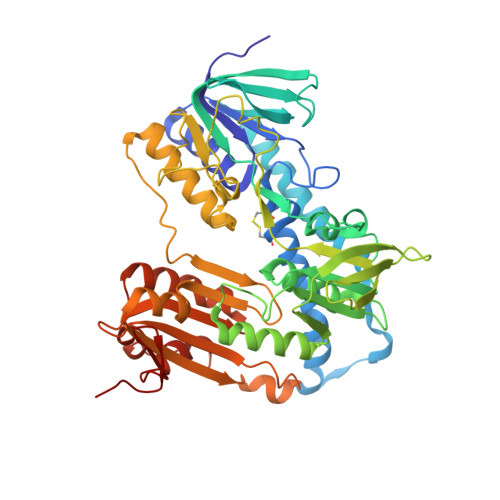Optimization of Potent and Specific Trypanothione Reductase Inhibitors: A Structure-Based Drug Discovery Approach.
Battista, T., Federico, S., Brogi, S., Pozzetti, L., Khan, T., Butini, S., Ramunno, A., Fiorentino, E., Orsini, S., Di Muccio, T., Fiorillo, A., Exertier, C., Di Risola, D., Colotti, G., Gemma, S., Ilari, A., Campiani, G.(2022) ACS Infect Dis 8: 1687-1699
- PubMed: 35880849
- DOI: https://doi.org/10.1021/acsinfecdis.2c00325
- Primary Citation of Related Structures:
7NVP - PubMed Abstract:
Leishmania spp. are responsible for up to 1 million new cases each year. The current therapeutic arsenal against Leishmania is largely inadequate, and there is an urgent need for better drugs. Trypanothione reductase (TR) represents a druggable target since it is essential for the parasite and not shared by the human host. Here, we report the optimization of a novel class of potent and selective Li TR inhibitors realized through a concerted effort involving X-ray crystallography, synthesis, structure-activity relationship (SAR) investigation, molecular modeling, and in vitro phenotypic assays. 5-Nitrothiophene-2-carboxamides 3 , 6e , and 8 were among the most potent and selective TR inhibitors identified in this study. 6e and 8 displayed leishmanicidal activity in the low micromolar range coupled to SI > 50. Our studies could pave the way for the use of TR inhibitors not only against leishmaniasis but also against other trypanosomatidae due to the structural similarity of TR enzymes.
Organizational Affiliation:
Institute of Molecular Biology and Pathology (IBPM) of the National Research Council of Italy (CNR), c/o Department of Biochemical Sciences, Sapienza University of Rome, Piazzale A. Moro 5, 00185Roma, Italy.


















